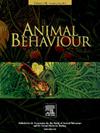Towards the integration of collective behaviour and social evolution
IF 2.3
2区 生物学
Q2 BEHAVIORAL SCIENCES
引用次数: 0
Abstract
Collective behaviour is ubiquitous in nature. Defined as individual-level local interactions that give rise to emergent patterns at the group level, collective behaviour spans multiple biological levels, including molecules, cells, organisms and societies. Many collective behaviours are beneficial at the group level and observed even in species that form groups of low genetic relatedness. However, group-level benefits alone are often not sufficient to explain the evolution and maintenance of cooperative behaviours in well-mixed populations. Establishing such an understanding is the purview of social evolution; however, theoretical tools from social evolution have seldom been applied to the field of collective behaviour. Towards closing this research gap, I present a case study using multilevel selection theory to study the evolution of coordinated (aligned) collective behaviour under threat of predation. I derive analytical solutions, demonstrating that the group-level benefits of collective behaviour can lead to its evolution, even when the behaviour is initially costly at the individual level. To test the model's predictions, I suggest we will be able to tease apart the levels of selection using biohybrid experimental systems, which integrate virtual prey with real-life predators. In sum, I suggest (and then demonstrate) that the precise application of social evolution theory can provide testable hypotheses, towards unravelling how collective behaviours evolved.
迈向集体行为与社会进化的整合
集体行为在自然界中无处不在。集体行为被定义为个体层面的局部相互作用,在群体层面上产生涌现模式,它跨越多个生物层面,包括分子、细胞、生物体和社会。许多集体行为在群体水平上是有益的,甚至在形成低遗传亲缘关系群体的物种中也可以观察到。然而,群体层面的利益本身往往不足以解释在混合良好的群体中合作行为的进化和维持。建立这样的理解是社会进化的范围;然而,来自社会进化的理论工具很少被应用于集体行为领域。为了缩小这一研究差距,我提出了一个案例研究,使用多层次选择理论来研究在捕食威胁下协调(对齐)集体行为的进化。我得出了分析性的解决方案,证明了集体行为在群体层面上的利益可以导致它的进化,即使这种行为最初在个人层面上是昂贵的。为了验证模型的预测,我建议我们可以使用生物杂交实验系统来梳理选择的层次,该系统将虚拟猎物与现实捕食者结合起来。总之,我建议(然后证明)社会进化理论的精确应用可以提供可测试的假设,以揭示集体行为是如何进化的。
本文章由计算机程序翻译,如有差异,请以英文原文为准。
求助全文
约1分钟内获得全文
求助全文
来源期刊

Animal Behaviour
生物-动物学
CiteScore
4.60
自引率
8.00%
发文量
236
审稿时长
10.2 weeks
期刊介绍:
Growing interest in behavioural biology and the international reputation of Animal Behaviour prompted an expansion to monthly publication in 1989. Animal Behaviour continues to be the journal of choice for biologists, ethologists, psychologists, physiologists, and veterinarians with an interest in the subject.
 求助内容:
求助内容: 应助结果提醒方式:
应助结果提醒方式:


